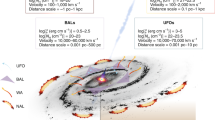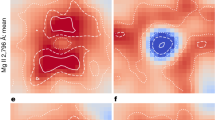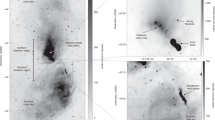Abstract
It is twenty years since the seminal works by Magorrian and co-authors and by Silk and Rees, which, along with other related work, ignited an explosion of publications connecting active galactic nucleus (AGN)-driven outflows to galaxy evolution. With a surge in observations of AGN outflows, studies are attempting to test AGN feedback models directly using the outflow properties. With a focus on outflows traced by optical and CO emission lines, we discuss significant challenges that greatly complicate this task, from both an observational and theoretical perspective. We highlight the observational uncertainties involved and the assumptions required when deriving kinetic coupling efficiencies (that is, outflow kinetic power as a fraction of AGN luminosity) from typical observations. Based on recent models we demonstrate that extreme caution should be taken when comparing observationally derived kinetic coupling efficiencies to coupling efficiencies from fiducial feedback models.
This is a preview of subscription content, access via your institution
Access options
Access Nature and 54 other Nature Portfolio journals
Get Nature+, our best-value online-access subscription
$29.99 / 30 days
cancel any time
Subscribe to this journal
Receive 12 digital issues and online access to articles
$119.00 per year
only $9.92 per issue
Buy this article
- Purchase on Springer Link
- Instant access to full article PDF
Prices may be subject to local taxes which are calculated during checkout


Similar content being viewed by others
References
Baade, W. & Minkowski, R. Identification of the radio sources in Cassiopeia, Cygnus A, and Puppis A. Astrophys. J 119, 206–214 (1954).
Burbidge, G. R. Nuclear energy generation and dissipation in galaxies. Publ. Astron. Soc. Pac. 70, 83–89 (1958).
Matthews, T. A. & Sandage, A. R. Optical identification of 3C 48, 3C 196, and 3C 286 with stellar objects. Astrophys. J. 138, 30–56 (1963).
Pacholczyk, A. G. & Weymann, R. Proceedings of the conference on Seyfert galaxies and related objects, held at Steward Observatory, University of Arizona, 14–16 February 1968. Astron. J. 73, 836–841 (1968).
Saslaw, W. C. Theory of galactic nuclei. In The Formation and Dynamics of Galaxies Vol. 58 (ed. Shakeshaft, J. R.) IAU Symp. 305–334 (1974).
Rees, M. J. Black hole models for active galactic nuclei. Annu. Rev. Astron. Astrophys. 22, 471–506 (1984).
Soltan, A. Masses of quasars. Mon. Not. R. Astron. Soc. 200, 115–122 (1982).
Yu, Q. & Tremaine, S. Observational constraints on growth of massive black holes. Mon. Not. R. Astron. Soc. 335, 965–976 (2002).
Fabian, A. C. Observational evidence of active galactic nuclei feedback. Annu. Rev. Astron. Astrophys. 50, 455–489 (2012).
Binney, J. & Tabor, G. Evolving cooling flows. Mon. Not. R. Astron. Soc. 276, 663–678 (1995).
Ciotti, L. & Ostriker, J. P. Cooling flows and quasars: different aspects of the same phenomenon? I. Concepts. Astrophys. J. Lett. 487, L105–L108 (1997).
Valageas, P. & Silk, J. The entropy history of the universe. Astron. Astrophys. 350, 725–742 (1999).
McNamara, B. R. & Nulsen, P. E. J. Mechanical feedback from active galactic nuclei in galaxies, groups and clusters. New J. Phys. 14, 055023 (2012).
Ikeuchi, S. Theory of galaxy formation triggered by quasar explosions. Publ. Astron. Soc. Jpn 33, 211–222 (1981).
Natarajan, P., Sigurdsson, S. & Silk, J. Quasar outflows and the formation of dwarf galaxies. Mon. Not. R. Astron. Soc. 298, 577–582 (1998).
Sanders, D. B., Soifer, B. T., Elias, J. H., Neugebauer, G. & Matthews, K. Warm ultraluminous galaxies in the IRAS survey — The transition from galaxy to quasar? Astrophys. J. Lett. 328, L35–L39 (1988).
Magorrian, J. et al. The demography of massive dark objects in galaxy centers. Astron. J. 115, 2285–2305 (1998).
Gebhardt, K. et al. A relationship between nuclear black hole mass and galaxy velocity dispersion. Astrophys. J. Lett. 539, L13–L16 (2000).
Ferrarese, L. & Merritt, D. A fundamental relation between supermassive black holes and their host galaxies. Astrophys. J. Lett. 539, L9–L12 (2000).
Silk, J. & Rees, M. J. Quasars and galaxy formation. Astron. Astrophys. 331, L1–L4 (1998).
Haehnelt, M. G., Natarajan, P. & Rees, M. J. High-redshift galaxies, their active nuclei and central black holes. Mon. Not. R. Astron. Soc. 300, 817–827 (1998).
King, A. Black holes, galaxy formation, and the M BH–σ relation. Astrophys. J. Lett. 596, L27–L29 (2003).
Peng, C. Y. How mergers may affect the mass scaling relation between gravitationally bound systems. Astrophys. J. 671, 1098–1107 (2007).
Anglés-Alcázar, D., Davé, R., Faucher-Giguère, C.-A., Özel, F. & Hopkins, P. F. Gravitational torque-driven black hole growth and feedback in cosmological simulations. Mon. Not. R. Astron. Soc. 464, 2840–2853 (2017).
Cattaneo, A. et al. The role of black holes in galaxy formation and evolution. Nature 460, 213–219 (2009).
Benson, A. J. et al. What shapes the luminosity function of galaxies? Astrophys. J. 599, 38–49 (2003).
Granato, G. L., De Zotti, G., Silva, L., Bressan, A. & Danese, L. A physical model for the coevolution of QSOs and their spheroidal hosts. Astrophys. J. 600, 580–594 (2004).
Springel, V., Di Matteo, T. & Hernquist, L. Black holes in galaxy mergers: the formation of red elliptical galaxies. Astrophys. J. Lett. 620, L79–L82 (2005).
Rodrguez Zaurn, J., Tadhunter, C. N., Rose, M. & Holt, J. The importance of warm, AGN-driven outflows in the nuclear regions of nearby ULIRGs. Mon. Not. R. Astron. Soc. 432, 138–166 (2013).
Storchi-Bergmann, T. et al. Feeding versus feedback in NGC4151 probed with Gemini NIFS — II. Kinematics. Mon. Not. R. Astron. Soc. 402, 819–835 (2010).
Holt, J., Tadhunter, C. N., Morganti, R. & Emonts, B. H. C. The impact of the warm outflow in the young (GPS) radio source and ULIRG PKS 1345 + 12 (4C 12.50). Mon. Not. R. Astron. Soc. 410, 1527–1536 (2011).
Sanmartim, D., Storchi-Bergmann, T. & Brotherton, M. S. 2D stellar population and gas kinematics of the inner 1.5 kpc of the post-starburst quasar SDSS J0210–0903. Mon. Not. R. Astron. Soc. 428, 867–881 (2013).
Harrison, C. M., Alexander, D. M., Mullaney, J. R. & Swinbank, A. M. Kiloparsec-scale outflows are prevalent among luminous AGN: outflows and feedback in the context of the overall AGN population. Mon. Not. R. Astron. Soc. 441, 3306–3347 (2014).
Barbosa, F. K. B., Storchi-Bergmann, T., McGregor, P., Vale, T. B. & Rogemar Riffel, A. Modelling the [Fe ii] λ1.644 μm outflow and comparison with H2 and H+ kinematics in the inner 200 pc of NGC 1068. Mon. Not. R. Astron. Soc. 445, 2353–2370 (2014).
Garca-Burillo, S. et al. Molecular line emission in NGC 1068 imaged with ALMA. I. An AGN-driven outflow in the dense molecular gas. Astron. Astrophys. 567, A125 (2014).
Feruglio, C. et al. The multi-phase winds of Markarian 231: from the hot, nuclear, ultra-fast wind to the galaxy-scale, molecular outflow. Astron. Astrophys. 583, A99 (2015).
Husemann, B. et al. Large-scale outflows in luminous QSOs revisited. The impact of beam smearing on AGN feedback efficiencies. Astron. Astrophys. 594, A44 (2016).
Karouzos, M., Woo, J.-H. & Bae, H.-J. Unravelling the complex structure of AGN-driven outflows. II. Photoionization and energetics. Astrophys. J. 833, 171 (2016).
Bischetti, M. et al. The WISSH quasars project. I. Powerful ionised outflows in hyper-luminous quasars. Astron. Astrophys. 598, A122 (2017).
Rose, M. et al. Quantifying the AGN-driven outflows in ULIRGs (QUADROS) — I: VLT/Xshooter observations of nine nearby objects. Mon. Not. R. Astron. Soc. 474, 128–156 (2018).
Wylezalek, D. & Morganti, R. Questions and challenges of what powers galactic outflows in active galactic nuclei. Nat. Astron. https://doi.org/10.1038/s41550-018-0409-0 (2018).
Costa, T., Rosdahl, J., Sijacki, D. & Haehnelt, M. G. Driving gas shells with radiation pressure on dust in radiation-hydrodynamic simulations. Mon. Not. R. Astron. Soc. 473, 4197–4219 (2018).
Crenshaw, D. M., Fischer, T. C., Kraemer, S. B. & Schmitt, H. R. Feedback from mass outflows in nearby active galactic nuclei. II. Outflows in the narrow-line region of NGC 4151. Astrophys. J. 799, 83 (2015).
Liu, G., Zakamska, N. L., Greene, J. E., Nesvadba, N. P. H. & Liu, X. Observations of feedback from radio-quiet quasars — II. Kinematics of ionized gas nebulae. Mon. Not. R. Astron. Soc. 436, 2576–2597 (2013).
Brusa, M. et al. X-shooter reveals powerful outflows in z: 1.5 X-ray selected obscured quasi-stellar objects. Mon. Not. R. Astron. Soc. 446, 2394–2417 (2015).
Fiore, F. et al. AGN wind scaling relations and the co-evolution of black holes and galaxies. Astron. Astrophys. 601, A143 (2017).
Heckman, T. M., Miley, G. K., van Breugel, W. J. M. & Butcher, H. R. Emission-line profiles and kinematics of the narrow-line region in Seyfert and radio galaxies. Astrophys. J. 247, 403–418 (1981).
Cicone, C. et al. Massive molecular outflows and evidence for AGN feedback from CO observations. Astron. Astrophys. 562, A21 (2014).
González-Alfonso, E. et al. Molecular outflows in local ULIRGs: Energetics from multitransition OH analysis. Astrophys. J. 836, 11 (2017).
Sun, A.-L., Greene, J. E. & Zakamska, N. L. Sizes and kinematics of extended narrow-line regions in luminous obscured AGN selected by broadband images. Astrophys. J. 835, 222 (2017).
Rupke, D. S. N. & Veilleux, S. The multiphase structure and power sources of galactic winds in major mergers. Astrophys. J. 768, 75 (2013).
Cano-Diaz, M. et al. Observational evidence of quasar feedback quenching star formation at high redshift. Astron. Astrophys. 537, L8 (2012).
Barbosa, F. K. B., Storchi-Bergmann, T., Cid Fernandes, R., Winge, C. & Schmitt, H. Gemini/GMOS IFU gas velocity ‘tomography’ of the narrow line region of nearby active galaxies. Mon. Not. R. Astron. Soc. 396, 2–18 (2009).
Rupke, D. S. N., Gültekin, K. & Veilleux, S. Quasar-mode feedback in nearby type 1 quasars: Ubiquitous kiloparsec-scale outflows and correlations with black hole properties. Astrophys. J. 850, 40 (2017).
Villar-Martn, M. et al. Ionized outflows in luminous type 2 AGNs at z < 0.6: no evidence for significant impact on the host galaxies. Mon. Not. R. Astron. Soc. 460, 130–162 (2016).
Heckman, T. M., Armus, L. & Miley, G. K. On the nature and implications of starburst-driven galactic superwinds. Astrophys. J. Suppl. 74, 833–868 (1990).
Greene, J. E., Zakamska, N. L. & Smith, P. S. A spectacular outflow in an obscured quasar. Astrophys. J. 746, 86 (2012).
Harrison, C. M. et al. Storm in a ‘teacup’: a radio-quiet quasar with ~10 kpc radio-emitting bubbles and extreme gas kinematics. Astrophys. J. 800, 45 (2015).
Osterbrock, D. E. & Ferland, G. J. Astrophysics of Gaseous Nebulae and Active Galactic Nuclei (University Science Books, Sausalito, CA, 2006).
Perna, M., Lanzuisi, G., Brusa, M., Cresci, G. & Mignoli, M. An X-ray/SDSS sample. II. AGN-driven outflowing gas plasma properties. Astron. Astrophys. 606, A96 (2017).
Borguet, B. C. J., Arav, N., Edmonds, D., Chamberlain, C. & Benn, C. Major contributor to AGN feedback: VLT X-shooter observations of S iv BAL QSO outflows. Astrophys. J. 762, 49 (2013).
Chamberlain, C. & Arav, N. Large-scale outflow in quasar LBQS J1206 + 1052: HST/COS observations. Mon. Not. R. Astron. Soc. 454, 675–680 (2015).
Bolatto, A. D., Wolfire, M. & Leroy, A. K. The CO-to-H2 conversion factor. Annu. Rev. Astron. Astrophys. 51, 207–268 (2013).
Dasyra, K. M. et al. ALMA reveals optically thin, highly excited CO gas in the jet-driven winds of the galaxy IC 5063. Astron. Astrophys. 595, L7 (2016).
Richings, A. J. & Faucher-Giguère, C.-A. The origin of fast molecular outflows in quasars: molecule formation in AGN-driven galactic winds. Mon. Not. R. Astron. Soc. 474, 3673–3699 (2018).
Kakkad, D. et al. Tracing outflows in the AGN forbidden region with SINFONI. Astron. Astrophys. 592, A148 (2016).
Cicone, C. et al. The largely unconstrained multiphase nature of outflows in AGN host galaxies. Nat. Astron. https://doi.org/10.1038/s41550-018-0406-3 (2018).
Nesvadba, N. P. H. et al. Extreme gas kinematics in the z = 2.2 powerful radio galaxy MRC 1138–262: evidence for efficient active galactic nucleus feedback in the early universe? Astrophys. J. 650, 693–705 (2006).
Zakamska, N. L. & Greene, J. E. Quasar feedback and the origin of radio emission in radio-quiet quasars. Mon. Not. R. Astron. Soc. 442, 784–804 (2014).
Crichton, D. et al. Evidence for the thermal Sunyaev–Zel'dovich effect associated with quasar feedback. Mon. Not. R. Astron. Soc. 458, 1478–1492 (2016).
Di Matteo, T., Springel, V. & Hernquist, L. Energy input from quasars regulates the growth and activity of black holes and their host galaxies. Nature 433, 604–607 (2005).
King, A. & Pounds, K. Powerful outflows and feedback from active galactic nuclei. Annu. Rev. Astron. Astrophys. 53, 115–154 (2015).
Roth, N., Kasen, D., Hopkins, P. F. & Quataert, E. Three-dimensional radiative transfer calculations of radiation feedback from massive black holes: outflow of mass from the dusty ‘torus’. Astrophys. J. 759, 36 (2012).
Veilleux, S. et al. Quasar feedback in the ultraluminous infrared galaxy F11119+3257: connecting the accretion disk wind with the large-scale molecular outflow. Astrophys. J. 843, 18 (2017).
Richings, A. J. & Faucher-Giguere, C.-A. Radiative cooling of swept up gas in AGN-driven galactic winds and its implications for molecular outflows. Preprint available at https://arxiv.org/abs/1710.09433 (2017).
Bourne, M. A., Zubovas, K. & Nayakshin, S. The resolution bias: low-resolution feedback simulations are better at destroying galaxies. Mon. Not. R. Astron. Soc. 453, 1829–1842 (2015).
Weinberger, R. et al. Simulating galaxy formation with black hole driven thermal and kinetic feedback. Mon. Not. R. Astron. Soc. 465, 3291–3308 (2017).
Booth, C. M. & Schaye, J. Cosmological simulations of the growth of supermassive black holes and feedback from active galactic nuclei: method and tests. Mon. Not. R. Astron. Soc. 398, 53–74 (2009).
Choi, E., Ostriker, J. P., Naab, T. & Johansson, P. H. Radiative and momentum-based mechanical active galactic nucleus feedback in a three-dimensional galaxy evolution code. Astrophys. J. 754, 125 (2012).
Barai, P. et al. Quasar outflows at z ≥ 6: the impact on the host galaxies. Mon. Not. R. Astron. Soc. 473, 4003–4020 (2018).
Wagner, A. Y., Bicknell, G. V. & Umemura, M. Driving outflows with relativistic jets and the dependence of active galactic nucleus feedback efficiency on interstellar medium inhomogeneity. Astrophys. J. 757, 136 (2012).
McCourt, M., O'Leary, R. M., Madigan, A.-M. & Quataert, E. Magnetized gas clouds can survive acceleration by a hot wind. Mon. Not. R. Astron. Soc. 449, 2–7 (2015).
Zhang, D., Thompson, T. A., Quataert, E. & Murray, N. Entrainment in trouble: cool cloud acceleration and destruction in hot supernova-driven galactic winds. Mon. Not. R. Astron. Soc. 468, 4801–4814 (2017).
Costa, T., Sijacki, D. & Haehnelt, M. G. Feedback from active galactic nuclei: energy- versus momentum-driving. Mon. Not. R. Astron. Soc. 444, 2355–2376 (2014).
McCarthy, I. G. et al. Gas expulsion by quasar-driven winds as a solution to the overcooling problem in galaxy groups and clusters. Mon. Not. R. Astron. Soc. 412, 1965–1984 (2011).
Harrison, C. M. Impact of supermassive black hole growth on star formation. Nat. Astron. 1, 0165 (2017).
Cresci, G. & Maiolino, R. Observing positive and negative AGN feedback. Nat. Astron. https://doi.org/10.1038/s41550-018-0404-5 (2018).
Nims, J., Quataert, E. & Faucher-Giguère, C.-A. Observational signatures of galactic winds powered by active galactic nuclei. Mon. Not. R. Astron. Soc. 447, 3612–3622 (2015).
Kerzendorf, W. E. Knowledge discovery through text-based similarity searches for astronomy literature. Preprint at https://arxiv.org/abs/1705.05840 (2017).
Feruglio, C. et al. Quasar feedback revealed by giant molecular outflows. Astron. Astrophys. 518, L155 (2010).
Couto, G. S. et al. Kinematics and excitation of the nuclear spiral in the active galaxy Arp 102B. Mon. Not. R. Astron. Soc. 435, 2982–3000 (2013).
Sun, A.-L., Greene, J. E., Zakamska, N. L. & Nesvadba, N. P. H. ALMA observations of a candidate molecular outflow in an obscured quasar. Astrophys. J. 790, 160 (2014).
Schönell, A. J., Riffel, R. A., Storchi-Bergmann, T. & Winge, C. Feeding versus feedback in AGN from near-infrared IFU observations: the case of Mrk 766. Mon. Not. R. Astron. Soc. 445, 414–427 (2014).
Morganti, R., Oosterloo, T., Oonk, J. B. R., Frieswijk, W. & Tadhunter, C. The fast molecular outflow in the Seyfert galaxy IC 5063 as seen by ALMA. Astron. Astrophys. 580, A1 (2015).
Zschaechner, L. K. et al. The molecular wind in the nearest Seyfert galaxy Circinus revealed by ALMA. Astrophys. J. 832, 142 (2016).
Couto, G. S., Storchi-Bergmann, T. & Schnorr-Müller, A. Gas rotation, shocks and outflow within the inner 3 kpc of the radio galaxy 3C 33. Mon. Not. R. Astron. Soc. 469, 1573–1586 (2017).
Bae, H.-J. et al. The limited impact of outflows: integral-field spectroscopy of 20 local AGNs. Astrophys. J. 837, 91 (2017).
Hopkins, P. F. & Elvis, M. Quasar feedback: more bang for your buck. Mon. Not. R. Astron. Soc. 401, 7–14 (2010).
Dubois, Y. et al. Dancing in the dark: galactic properties trace spin swings along the cosmic web. Mon. Not. R. Astron. Soc. 444, 1453–1468 (2014).
Schaye, J. et al. The EAGLE project: simulating the evolution and assembly of galaxies and their environments. Mon. Not. R. Astron. Soc. 446, 521–554 (2015).
Acknowledgements
We thank the participants of ‘The reality and myths of AGN feedback’ meeting for inspiring this Perspective and providing constructive comments and the Lorentz Center staff for its organization. We thank A. Richings for useful discussions and W. Kerzendorf for verifying that the trends in Fig. 1 are reproducible using the full text in all articles on arXiv and the algorithm in ref. 89. We acknowledge support from DFG ‘Cluster of Excellence Origin and Structure of the Universe’.
Author information
Authors and Affiliations
Contributions
C.M.H., T.C. and C.N.T. contributed to the writing. C.M.H., A.F., D.K., M.P. and G.V. obtained the information in Fig. 1 and Fig. 2.
Corresponding author
Ethics declarations
Competing interests
The authors declare no competing interests.
Additional information
Publisher’s note: Springer Nature remains neutral with regard to jurisdictional claims in published maps and institutional affiliations.
Rights and permissions
About this article
Cite this article
Harrison, C.M., Costa, T., Tadhunter, C.N. et al. AGN outflows and feedback twenty years on. Nat Astron 2, 198–205 (2018). https://doi.org/10.1038/s41550-018-0403-6
Received:
Accepted:
Published:
Issue Date:
DOI: https://doi.org/10.1038/s41550-018-0403-6
This article is cited by
-
Science with a Small Two-Band UV-Photometry Mission III: Active Galactic Nuclei and Nuclear Transients
Space Science Reviews (2024)
-
Cold gas removal from the centre of a galaxy by a low-luminosity jet
Nature Astronomy (2022)
-
Anisotropic satellite galaxy quenching modulated by black hole activity
Nature (2021)
-
Compact steep-spectrum and peaked-spectrum radio sources
The Astronomy and Astrophysics Review (2021)
-
Cool outflows in galaxies and their implications
The Astronomy and Astrophysics Review (2020)



